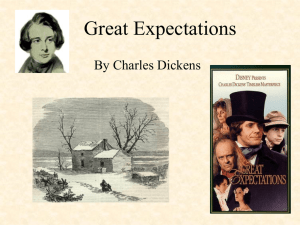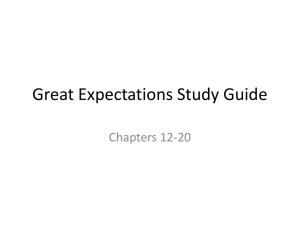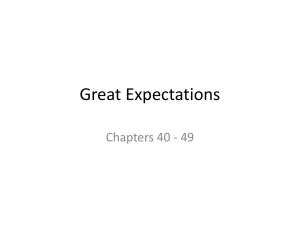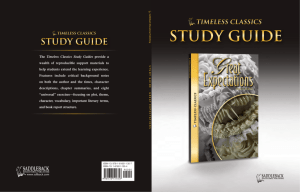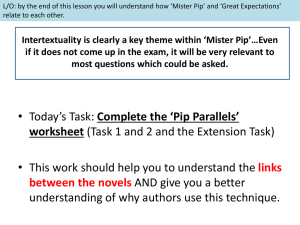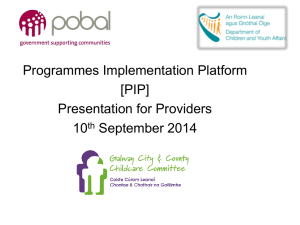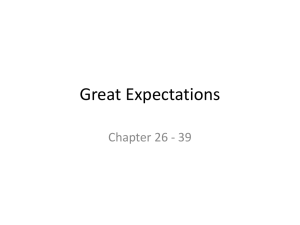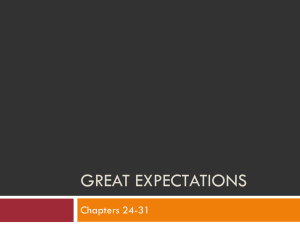Great Expectations Study Guide1
advertisement
1. 2. 3. 4. 5. What narrative point of view has Dickens chosen for this novel? What can the reader expect in a story told from this point of view? Briefly describe the convict. What evidence is there that the convict has human qualities and is not merely a criminal? How does Dickens establish the social class of the convict? How does Dickens create some sympathy for the convict? 1. 2. Contrast Pip’s description of Mrs. Joe with his description of Joe. What important exposition (explanation/clarification) is the reader given in this chapter? 1. 2. How does the setting mirror Pip’s state of mind? In what ways does Pip show himself to be a compassionate young boy? 1. 2. 3. How does Chapter 4 begin and end? What observation does Pip make about Joe’s dress and appearance? What are the sources of humor in this chapter? 1. 2. 3. 4. 5. How is the capture of the two convicts ironic? What facts do we learn about the convicts in this chapter? What does the treatment of the stolen pie suggest about the characters of the convict and Joe? Why does the convict go out of his way to clear Pip of any blame for the missing food? What indications show that the plotline of the convict is not over? 1. Why does Pip love Joe? What reason does he give for keeping the truth of his crimes from Joe? 1. 2. 3. Chapter 7 is the end of the third weekly installment of the book. What structural purpose does it serve? How are Biddy and Pip alike? Compare Joe’s dialect with the convict’s (which was shown in Chapter 1). 1. 2. 3. 4. 5. How does Dickens ridicule the city businessmen in this chapter? What does the reader learn about Mr. Pumblechook from a glimpse into his home life? Why is the Manor House also called Satis House? How is the name “Satis House” ironic? Describe Miss Havishman in detail and her interaction/feelings towards Pip. How has Pip’s character developed after interacting with Estella? 1. How does Dickens reinforce Pip and Joe’s closeness? Use the following passage from the book to answer the next two questions. “That was a memorable day to me, for it made great changes in me. But, it is the same way with any life. Imagine one selected day struck out of it, and think how different its course would have been. Pause, you who read this, and think for a moment of the long chain of iron or gold, of thorns or flowers, that would never have bound you, but for the formation of the first link on one memorable day” (55). 2. What “links” in Pip’s “chain” are begun the day he visits Satis House? 3. What effect is created by Dickens allowing his adult narrator to pause in the narrative and address the reader directly? 1. 2. 3. 4. What steps does Pip take to improve himself? What two things does the stranger do to suggest a connection with the convict from the beginning of the book? What is the “invisible gun” referred to in Dickens’ description of the stranger? How does this connect to Pip’s nightmares? What two major plotlines begin to converge at the end of this chapter? 1. 2. 3. 4. Describe the Pockets. What is the significance of Pip’s saying of the man he meets on the stairway, “He was nothing to me, and I could have had no foresight then, that he ever would be anything to me”? Explain the effect Dickens is creating by using the 1st-person protagonist narrator. What suspicions about Miss Havisham are confirmed for the reader in this chapter? 5. 6. Pip fights a young man. How does the young man inspire Pip with great respect? In the following passage, what is the significance of the light from Joe’s forge? “…when I neared home the light on the spit of sand off the point on the marshes was gleaming against a black night-sky, and Joe’s furnace was flinging a path of fire across the road” (72).
